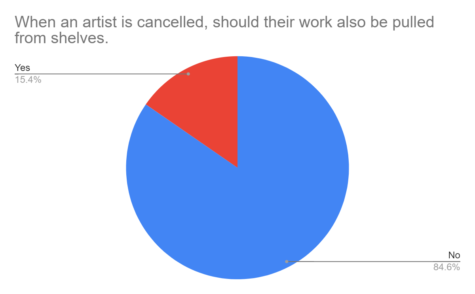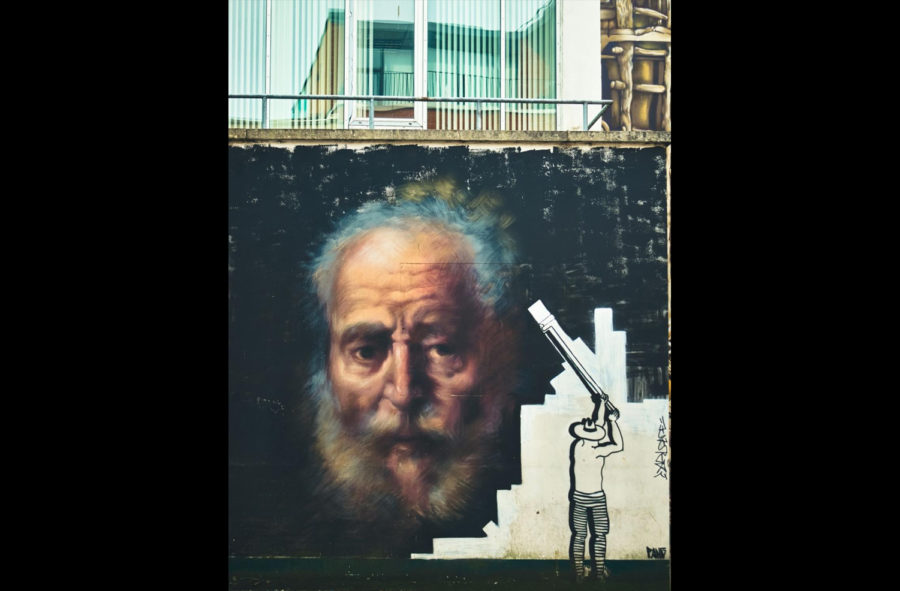Don’t Touch the Art!
In an era of cancellation and censorship, it is time that we start recognizing the difference between the artist’s work and the artist herself.
A mural of a cleaner erasing a gorgeous painting. Although it’s only a mural, it displays how for the sake of banality and conformity, gorgeous works of art can be removed, and the people behind it can be deemed vandals.
Have you ever created something that you’re proud of, such as a short story, a work of art, or a song? It may have been something that you spent years creating, as you drafted and deleted and re-designed and perfected. After going through the depths of revision, you finally publish your work. It receives a highly positive reception, and you finally rest…until old messages you sent are dug up and spread around the internet, screenshots of what is now considered a faux pas. You’re forced to leave the limelight. You think, at least my work lives on! — only to have that dream shattered. Your creation gets banned, pulled, removed from social media, forums, and every retailer you’ve ever known.
This experience is becoming increasingly common amongst artists, their work, or works with which they are affiliated.
For consumers, they lose the ability to obtain and view certain media. For artists, they lose the right to expression: one wrong word can remove not just you, but your work as well. And for society? It means the loss of art and media, and the erasure of culture and knowledge.
Debunking a Common Argument
A common argument for the erasure of media comes from the idea that once a person is “cancelled,” whether for a crime or social conduct, they should no longer be supported. And that’s fine. If you disagree with a politician’s point of view and think others shouldn’t donate to them, you can attempt to change their opinion through conversation. But you cannot block doors and smash donation boxes.
There’s a great distinction between cannot and should not. “Should” indicates an opinion, a personal matter where everyone can have a different perspective, while reaching across the aisle to have a civil discourse. “Cannot,” however, indicates no choice; you have no say in the matter.
If you believe an artist should not be supported, you can choose to not support them. But don’t also prevent others from making that decision. Let them research, discuss, and formulate their opinions. In the end, it is their decision to make.
Nothing to Gain, Everything to Lose
Removing art is the loss of an individual’s ideas, of diversity in thought, and of the historical record. And even the most dull and destructive of works, written by the most morally bankrupt people, have reasons to exist. They often give an explanation and motive for their actions.
Is there anything to gain from removing art? One may argue that it creates a clear moral line within our society, while another would contend that there’s no reason to keep what’s clearly rubbish. But once again, this is merely an opinion and, similar to the case of ‘should’ and ‘can,’ it is not something for one person to pass judgement on. Morality is a grey area; it varies by person and changes through time. And even if the artist is a “ bad person,” his or her work may still hold significant value in society.
Pablo Picasso may have been a misogynist, but he was also a pioneer of Cubism. His works revolutionized the modern art world, and had major political power (‘Guernica’). Does that mean we should remove his work? “The importance of his works and the way they changed art cannot be ignored, but as a person he should not be admired because his transgressions in his personal life should not be overlooked either,” said Giulia Cartegni ‘23.
Art is Independent of the Artist
Although art is a representation of the individual artist and that artist’s views, it also lives on independently, separate from the artist.
Think about the movies and shows that you watch. We often don’t think of the screenwriter or the director. We think of the plot and the story. It may represent parts of the director, screenwriter, or producer’s life, but it exists independently as its own property.
This line of thinking is also apparent in literature, specifically realistic fiction and fantasy. When thinking of themes regarding maturation and coming-of-age, books such as Catcher in the Rye and The Outsiders come to mind – not necessarily the authors who wrote them. Likewise, common thematic such as dwarves and high elves would remind you of Lord of the Rings, The Hobbit, or even The Name of the Wind. And you might not immediately think of J.R.R Tolkien, the man who practically created modern fantasy as a genre.
Art is already independent. When you purchase a game, you think of the genre and franchise the game is in, not the publisher or designers behind it. And when that game is reviewed, we should not be grading the creator herself, but rather the quality of the work itself.
A General Consensus

Separating the art and the artist isn’t an unpopular idea either. In a poll conducted with students of Bronx Science (at right), I found that around 85% of students believe that art can be separated from the artist. One student in particular, Yu Xia ’22, said, “An artist’s work can be completely separate from the artist herself, because there isn’t a defined perspective when the medium is meant to be abstract.” Art may be influenced by a perspective, but it’s not tied to it. Art is left to interpretation.
Art may be influenced by a perspective, but it’s not tied to it. It is left to your interpretation. Therefore, interpret this article as you will. After all, it is your right to do so.
Is there anything to gain from removing art? One may argue that it creates a clear moral line within our society, while another would contend that there’s no reason to keep what’s clearly rubbish.
Tiankuo Zhang is an Editor-In-Chief for 'The Science Survey.' He sees journalism as something that has withstood the test of time and finds the transcriptions...

